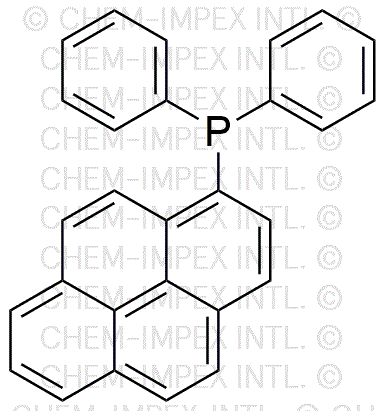Diphenyl-1-pyrenylphosphine is widely utilized in research focused on:
- Organic Photovoltaics: This compound is used as a hole transport material in organic solar cells, enhancing their efficiency by improving charge mobility and stability.
- Fluorescent Probes: It serves as a fluorescent probe in biochemical assays, allowing researchers to track molecular interactions and dynamics in real-time.
- Photonic Devices: The compound is incorporated into photonic devices for its luminescent properties, aiding in the development of advanced light-emitting diodes (LEDs) and lasers.
- Material Science: It is employed in the synthesis of novel materials with tailored electronic properties, which can be applied in various electronic and optoelectronic applications.
- Chemical Sensors: Diphenyl-1-pyrenylphosphine is used in the development of chemical sensors, providing high sensitivity and selectivity for detecting specific analytes in environmental monitoring.
General Information
Properties
Safety and Regulations
Applications
Diphenyl-1-pyrenylphosphine is widely utilized in research focused on:
- Organic Photovoltaics: This compound is used as a hole transport material in organic solar cells, enhancing their efficiency by improving charge mobility and stability.
- Fluorescent Probes: It serves as a fluorescent probe in biochemical assays, allowing researchers to track molecular interactions and dynamics in real-time.
- Photonic Devices: The compound is incorporated into photonic devices for its luminescent properties, aiding in the development of advanced light-emitting diodes (LEDs) and lasers.
- Material Science: It is employed in the synthesis of novel materials with tailored electronic properties, which can be applied in various electronic and optoelectronic applications.
- Chemical Sensors: Diphenyl-1-pyrenylphosphine is used in the development of chemical sensors, providing high sensitivity and selectivity for detecting specific analytes in environmental monitoring.
Documents
Safety Data Sheets (SDS)
The SDS provides comprehensive safety information on handling, storage, and disposal of the product.
Product Specification (PS)
The PS provides a comprehensive breakdown of the product’s properties, including chemical composition, physical state, purity, and storage requirements. It also details acceptable quality ranges and the product's intended applications.
Certificates of Analysis (COA)
Search for Certificates of Analysis (COA) by entering the products Lot Number. Lot and Batch Numbers can be found on a product’s label following the words ‘Lot’ or ‘Batch’.
*Catalog Number
*Lot Number
Certificates Of Origin (COO)
This COO confirms the country where the product was manufactured, and also details the materials and components used in it and whether it is derived from natural, synthetic, or other specific sources. This certificate may be required for customs, trade, and regulatory compliance.
*Catalog Number
*Lot Number
Safety Data Sheets (SDS)
The SDS provides comprehensive safety information on handling, storage, and disposal of the product.
DownloadProduct Specification (PS)
The PS provides a comprehensive breakdown of the product’s properties, including chemical composition, physical state, purity, and storage requirements. It also details acceptable quality ranges and the product's intended applications.
DownloadCertificates of Analysis (COA)
Search for Certificates of Analysis (COA) by entering the products Lot Number. Lot and Batch Numbers can be found on a product’s label following the words ‘Lot’ or ‘Batch’.
*Catalog Number
*Lot Number
Certificates Of Origin (COO)
This COO confirms the country where the product was manufactured, and also details the materials and components used in it and whether it is derived from natural, synthetic, or other specific sources. This certificate may be required for customs, trade, and regulatory compliance.


